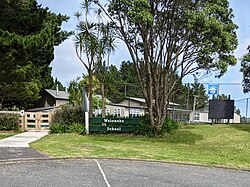|
Waioneke
Waioneke is a locality on the Te Korowai-o-Te-Tonga Peninsula of the Kaipara Harbour, in the Rodney District of New Zealand. Parakai is 22 km to the south-east, and the road continues another 14 km to the north-west. Rangitira Beach and Woodhill Forest are to the west, and Omokoiti Flats and the southern Kaipara Harbour are to the east.[1][2] HistoryA Māori pā existed at Waioneke prior to European settlement of the area.[3] The Waioneke block was taken up in 1868 by Daniel Pollen (who later became Premier of New Zealand) and William Spearman Young, to graze cattle.[4][5] A Waioneke Road Board was formed after 1884, and was responsible for forming and maintaining roads over much of the South Head peninsula. The board was dissolved by 1899.[6] Waioneke was a centre of gum digging from 1880 to 1900.[7] Deer farming began in the area in the 1970s, and a processing plant was built in Waioneke.[8] The Kaipara Estate winery began in the Waioneke Valley in 1995.[9][10] DemographicsWaioneke is in an SA1 statistical area which covers 18.15 km2 (7.01 sq mi).[11] The SA1 area is part of the larger South Head statistical area.[12]
The SA1 statistical area had a population of 186 in the 2023 New Zealand census, an increase of 3 people (1.6%) since the 2018 census, and an increase of 72 people (63.2%) since the 2013 census. There were 99 males and 90 females in 66 dwellings.[15] 1.6% of people identified as LGBTIQ+. The median age was 49.7 years (compared with 38.1 years nationally). There were 33 people (17.7%) aged under 15 years, 30 (16.1%) aged 15 to 29, 87 (46.8%) aged 30 to 64, and 36 (19.4%) aged 65 or older.[14] People could identify as more than one ethnicity. The results were 93.5% European (Pākehā), 11.3% Māori, 1.6% Pasifika, and 4.8% Asian. English was spoken by 98.4%, Māori language by 1.6%, and other languages by 6.5%. No language could be spoken by 1.6% (e.g. too young to talk). The percentage of people born overseas was 9.7, compared with 28.8% nationally. Religious affiliations were 16.1% Christian, 1.6% Buddhist, and 1.6% New Age. People who answered that they had no religion were 77.4%, and 6.5% of people did not answer the census question.  Of those at least 15 years old, 15 (9.8%) people had a bachelor's or higher degree, 93 (60.8%) had a post-high school certificate or diploma, and 48 (31.4%) people exclusively held high school qualifications. The median income was $32,900, compared with $41,500 nationally. 12 people (7.8%) earned over $100,000 compared to 12.1% nationally. The employment status of those at least 15 was that 84 (54.9%) people were employed full-time and 27 (17.6%) were part-time.[14] EducationWaioneke School is a coeducational full primary (years 1–8) school with a roll of 99 students as of November 2024.[16][17] The school traces its origins to Mairetahi School, established in 1928. The school moved to its present site and took its current name in 1938.[18] Notes
External links |
||||||||||||||||||||||||||||||||||||||||||||||||
Portal di Ensiklopedia Dunia

